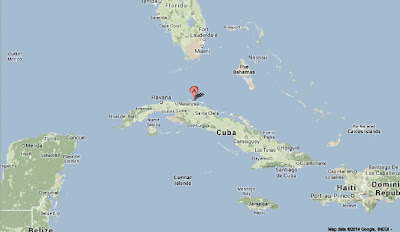The United States Geological Survey recorded a Magnitude 5.1 Earthquake at a depth of 10 km beneath Cayo Cruz del Padre, an island of the north coast of Cuba, slightly before 4.00 pm local time (slightly before 9.00 pm GMT) on Thursday 9 January 2013. There are no reports of any damage or injuries associated with this event, however it was felt in Havana, 174 km to the west of the epicenter, where some buildings were temporarily evacuated as a precaution, as well as across much of southern Florida.
The approximate location of the 9 January 2013 Cayo Cruz del Padre Earthquake. Google Maps.
Cuba lies on the southern portion of the North American Plate, to the north of the Septentrional Fault Zone, which forms the boundary with the Gonâve Microplate, a small tectonic plate underlying northern Jamaica and most of the island of Hispaniola. The Gonâve Microplate is moving east relative to the North American Plate, pushed by the Mid-Cayman Spreading centre to the west of Jamaica.
To the south the Gonâve Microplate is separated from the Caribbean Plate by the Enriquilo-Plantain Garden Fault Zone, which runs across Southern Haiti and the Dominican Republic. To the west the fault runs through central Jamaica. The Caribbean Plate is rotating clockwise, effectively moving east relative to the Gonâve Microplate.
None of these movements are smooth, with rock formations at the boundaries of the plates constantly sticking together then breaking apart as the pressure from the plate movement builds up, triggering Earthquakes in the process.
See also Magnitude 3.4 Earthquake in the southeast Dominican Republic, Magnitude 3.1 Earthquake off the north coast of the Dominican Republic, Volcanic activity on Soufrière Hills, Montserrat, Earthquake in the Dominican Republic and Deepest hydrothermal vent communities yet found discovered in the Caribbean.
Follow Sciency Thoughts on Facebook.

